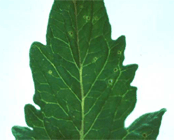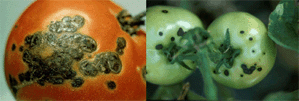Reports on Plant Diseases |
| RPD No. 910
- Bacterial Spot of Pepper and Tomato
|
October 1999
|
[ Symptoms
] [ Disease Cycle ] [ Control
]
Bacterial spot, caused by the bacterium Xanthomonas campestris
subsp. vesicatoria, is the most common of all
leaf and fruit diseases of sweet pepper in the Midwest. The disease is
also frequently found on tomatoes in warm, rainy seasons with frequent
or heavy dews. Fruit losses to peppers have approached 100 percent in
some Illinois fields during warm, wet seasons, while losses in southern
plant beds have been almost as high. Tomato fruit losses have been reported
as much as 50 percent in fields. Besides pepper and tomato, the causal
bacterium also infects black or deadly nightshade (Solanum
nigrum) and groundcherry (Physalis minima).
Back to Top
SYMPTOMS
Distinct symptoms occur on pepper and tomato fruit,
leaves, and seedlings and on pepper stems. Young leaves and fruit are
more susceptible than older tissues.
Pepper
Infected plants in the seedbed have small, irregular,
black spots, usually along the edges of the cotyledon leaves. Older plants
develop small, circular, pale green, slightly raised spots (lesions) on
the undersides of young leaves, with slight depressions on the corresponding
upper surfaces. As the spots enlarge, they become straw-colored with dark
brown margins. The center of the lesion often dies and collapses. As a
rule the spots do not merge. On older leaves of plants in the field, the
lesions are usually dark green, water-soaked, not noticeably raised, and
up to 1/8 or 1/4 inch in diameter. Later, these spots develop dead, pale
yellow centers with dark brown borders (Figure 1). When numerous, the
lesions remain dark brown with a paler brown center on the lower leaf
surface. Spotted leaves may turn yellow and fall at any time during the
season. When spots are numerous, entire leaves drop off while still green.
Seedlings infected in the plant bed may lose all but their top leaves.
Spots on pepper fruit are conspicuous, blisterlike, roughly
circular, and up to 1/4 inch in diameter, with a cracked, roughened, or
wartlike appearance (Figure 2). The spots are initially pale green but
soon turn brown. During moist weather, various secondary, decay-producing
bacteria and fungi enter through these lesions, causing the fruit to rot
before or after harvest. Stem spots are small, raised, and up to 1/4 inch
long. Eventually the cankers become roughened and light brown.
Tomato
Symptoms on young tomato plants are similar to those
on peppers. Seedlings in seedbeds may be so severely spotted that the
leaves turn yellow and drop. Leaf spots on older plants appear as small
(1/8 inch), water-soaked, translucent lesions that later turn brownish
black and may have a yellow halo (Figure 3). The lesions are somewhat
irregular and appear “greasy” on the upper leaf surface with
a translucent center and a black margin. The centers of the spots dry
out and frequently tear. Spots are most numerous on the younger leaves.
Only a few spots may cause a leaflet to turn yellow, wither, and drop
prematurely. Lesions on the flower stems (pedicels) also cause the blossoms
to blast and drop
Spots on green fruit first appear as small, black, raised
“pimples” surrounded by a narrow, water-soaked border (Figure
4, right). Somewhat older spots are black, slightly raised, superficial,
and up to 1/3 inch in diameter, with lobed margins and water-soaked borders
(halos). Later, the raised center sinks, forming a rough, brownish black
crater (Figure 4, left). Fruit spots are usually superficial and do not
penetrate to the seed cavity. The spots continue to enlarge until the
fruit matures. Ripe fruit are not susceptible due to their high acidity.
Spotting of the fruit and dropping of the flowers are the most serious
phases of the disease in the Midwest.
Back to Top
|

Figure 1.
Bacterial spot on pepper leaves.

Figure
2. Bacterial spot on pepper fruit.

Figure 3.
Bacterial spot lesions on the lower leaf surface of tomato. Note the yellow
halo around each lesion (courtesy Dr. B.J. Jacobsen).
|
|
The Xanthomonas bacterium has survived at least
16.5 months and possibly for years on and within seed. Cotyledon leaves
commonly become contaminated as they emerge from an infested seedcoat.
Seedlings and adjacent transplants become infected by bacteria splashed
or blown from nearby infected plants. Seedlings infected in the plant
bed carry the spot bacterium to the field or garden and are sources of
further infection. In the southern states the causal bacterium also may
overwinter on old infected pepper and tomato stems and roots on or above
the soil surface, in association with wheat roots, and possibly on black
nightshade and ground-cherry debris.
The bacterium apparently cannot overwinter in soil in the Midwest if all
infected plant debris is absent, including seed of tomato or pepper fruit
and weed reservoir hosts. Contaminated seed and transplants are
the most common source of primary infection in Illinois.
Overhead irrigation, frequent, warm, driving rains, and
long dew periods favor severe outbreaks of bacterial spot. Infection is
favored by 100 percent relative humidity for periods of 24 hours or longer.
The combination of wind and splashing rain, surface-drainage water, the
movement of equipment, and the handling of wet plants all aid in spreading
the bacteria throughout a field. Every plant in a field or garden can
become infected from just a few isolated infected plants.
The direction of spread within a field can often be correlated
with the direction of prevailing winds. Infections occur through natural
openings (stomates and hydathodes) on the leaves and stems, through abrasions
and broken hairs (trichomes) caused by rubbing together of plant parts,
or from windblown sand and insect punctures, through growth cracks in
the fruit, or other surface wounds.
The optimum temperature for infection is between 75°
and 86°F (24° to 30°C). Disease development is favored by
temperatures that fluctuate between 68° and 95°F (20° to 35°C).
Night temperatures of 75° to 82°F (23° to 27°C) favor
disease development, while low night temperatures (61°F or 16°C)
suppress disease development independent of daytime temperatures. High
nitrogen levels increase the severity of bacterial spot. Symptoms can
appear on tomato leaves about 6 days after inoculation and on pepper leaves
5 to 14 days after infection takes place. Different strains, races, or
pathotypes of the Xanthomonas organism can be distinguished according
to host range and symptoms. Some isolates favor pepper, others favor tomato,
while still others appear equally pathogenic on both pepper and tomato.
|

Figure
4. Bacterial spot lesions on two tomato fruits: (Left) older
lesions; (Right) young lesions..
|
Back to Top
|
Once established in tomato and pepper seedbeds and production
fields, bacterial spot is extremely difficult to control. The practices
outlined below are all important in controlling the disease. The rate
of disease spread in seedbeds and production fields and gardens can be
reduced by avoiding overhead irrigation, handling plants, and working
in and moving through fields and gardens when the plants are wet.
A. If plants are started from seed apply the following
control measures:
- Whenever possible, purchase only certified, disease-free
pepper and tomato seed grown in a semiarid area of the Pacific Northwest.
- Uncertified pepper and tomato seed may be freed of the bacterial
spot organism, seedborne anthracnose, the Rhizoctonia damping-off
fungus, and Phoma rot by a hot water soak. After the hot water treatment,
when both pepper and tomato seed have been cooled and are thoroughly
dry, dust the seed with a protectant fungicide to control seed rot
and damping-off. Follow the manufacturer’s directions as outlined
on the container label.
- Disinfest permanent seedbed soil with steam or a soil fumigant.
Whenever possible, do not locate seedbeds on soil where bacterial
spot has occurred within the past 2 years.
- In plant beds apply streptomycin (200 parts per million) plus a
fixed copper fungicide at about 2 pounds of active ingredient per
acre. The sprays should start within 4 or 5 days of emergence and
be continued at 4- or 5-day intervals using equipment that will provide
100 percent coverage of leaves and stems. When possible, spray when
the plants are dry and will not receive overhead irrigation or rain
for 24 hours. (Note: It is illegal to use streptomycin after transplant
time).
B. If transplants are purchased apply the following
control measures:
- If you buy transplants from the south, be certain they come from
fields certified as disease-free. This is critical!
- Follow a 2- or 3-year rotation of pepper and tomato with other unrelated
crops. Try to avoid small grains in the rotation since the causal
bacterium may survive near the surface of wheat roots during the winter
months. Also exclude weeds in the tomato-potato family such as black
nightshade and groundcherries. If ossible, tomato vines and pepper
plants should be removed or chopped up and buried as soon as possible
after harvest.
- Fertilize based on a soil test report and recommendations of Midwest
Vegetable Production Guide for Commercial Growers, available
from ITCS, University of Illinois P345, 1917 S. Wright St., Champaign,
IL 61820. Low fertility levels usually are associated with the most
severe levels of disease. Avoid excessive ferility levels, especially
before fruit set, as this can result in excessive foliage, low fruit
set, and an increase in the severity of bacterial spot. Strive to
maintain high balanced fertility.
- Planting peppers in narrow strips between early-planted corn may
help to reduce spread of bacterial spot during severe rain and wind
storms.
- After transplanting in the field or garden, apply fixed copper
plus mancozeb sprays on a 5- to 7-day schedule following the manufacturer’s
directions on the container labels. Premix the fixed copper and mancozeb
fungicides and start spraying 90 minutes after mixing. Continue the
sprays at least until the first-formed fruit are 1/3 their final size.
It is best to spray when plants are dry and just before rains are
expected. Pathotypes of Xanthomonas differ
in their sensitivity to copper. Bacterial spot control is improved
by adding mancozeb to fixed-copper fungicides. The addition of mancozeb
increases the amount of copper in solution. For more details on spraying
to control bacterial spot and other diseases of pepper and tomato
obtain a copy of Midwest Vegetable Production Guide for Commercial
Growers.
- Resistance to bacterial spot in both peppers and tomatoes appears
promising and degrees of resistance occur in commercial varieties.
Consult current seed catalogs and trade publications for resistant
varieties.
Back to Top |
Information concerning insecticides, weed control, varieties, and other recommendations
can be found in the Illinois Homeowners' Guide to Pest Management, available
at your nearest Extension office.
|



